I want to create a Subreddit Recommendation System
As the title says, I want to create a Reddit Community Recommendation System. I know that this obviously already exists, but I want to try recommending subreddits to users by using user interactions as embeddings in my recommender system. Furthermore, I want this to be a graph-based recommender system. How would I go about creating something like this?
Suggested: r/TigerGraph
Introduction
From a business point of view, the impact of this task would be in user acquisition and user retention. For current users, this would help expose them to subreddits they may be interested in, decreasing the likelihood of churn. For newer users without a few established subreddit communities they are a part of, immediately exposing them to similar communities may be beneficial in making them recurring users rather than one-time users. From a graph perspective, this problem is worth investigating as it can evaluate the relevancy of user interactions in a graph-like comment interaction structure as a basis for recommendation systems. We use a graph-based machine learning algorithm that assists in recommending subreddits to users based upon their interactions with other users in subreddits through comment chains.
Previous work has been done in the space of subreddit recommendation. In one attempt, a subreddit-to-subreddit interest network was built, where two subreddits are connected if a large portion of one subreddit's members are also active in the other. The model they use is K-means clustering, with another choosing to use the K-Nearest Neighbors algorithm. These examples along with others are not necessarily graph-based. Where graph community detection tasks of subreddits are used, the graphs are represented in relatively simple ways, primarily incorporating user and subreddit subscription relationships and using that data to make recommendations using "non-graphy" criteria such as similarity scores like Jaccard. By contrast, we look to use additional information which can be represented as graphs such as interactions between different users within subreddits in an attempt to leverage that interaction information as an indicator of user’s affinity for different communities/subreddits. We aim to use collaborative filtering encoded within our algorithm with user interactions to then accurately recommend subreddits to users.
In order to create an algorithm ourselves, we use a dataset provided and maintained by Jason Baumgartner which can be downloaded via their website pushshift.io at its data directory subdomain. There, data for Reddit users, subreddits, posts and comments among other things are hosted in monthly time increments going back to Reddit's inception in 2005. In order to ensure we didn't face any hardware limitations, we opted to use all comments prior to 2011 (2005 - Dec. 2010). However, because the data across all time periods is formatted in the same way, our work could easily be scaled up simply by downloading and using the more recent files. From it, we build a graph with 2 different types of nodes and 2 types of edges. Our 2 nodes are: User nodes and Subreddit nodes. Our first edge, interacted_with, connects users who interacted with other users. Second, the commented_in edge connects users to subreddits that they have interacted in via comments.
| Dataset Name | Contents |
| Users-Users | Connects users who interacted with one another |
| Subreddits | All Subreddits in the dataset and their keyword embeddings |
| Users | All users in the dataset and their keyword embeddings |
| Users-Subreddits | Connects users to subreddits they have commented in. |
All of the edges in this dataset are undirected, meaning that the relationship between any edge (vi, vj) in the graph is mutual. In total, our graph contains ~172,000 total vertices and ~1,200,000 edges. In a bit more detail, the graph contains 2,929 unique subreddit vertices, and ~170,000 user vertices along with ~865,000 "interacted_with" edges and ~345,000 "commented_in" edges.
In particular, this dataset allows us to make this evaluation on a network like the one that can be derived from Reddit. That is, one which encodes information about the interaction of users with other users within pre-defined communities. However, as many social media platforms use very similar representations for the links between users, this data can hopefully allow us to make more broad claims about social graphs and their usefulness in making predictions about users preferred communities.
 1
1 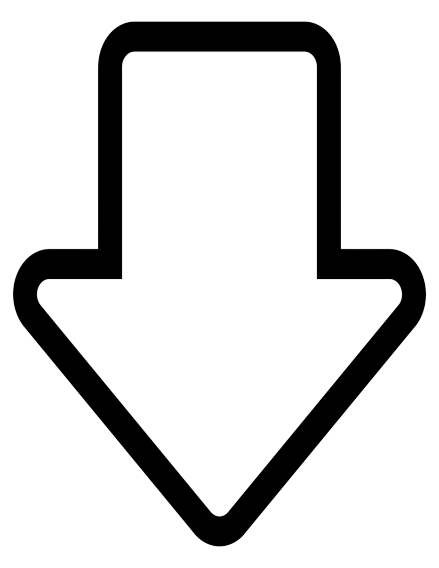
Why Graph?
 2
2 
Data Preparation
{
"author": "RaptorLog",
"author_flair_css_class": "",
"author_flair_text": "ro ru ",
"body": "Oh, I have been going crazy...",
"can_gild": true,
"controversiality": 0,
"created_utc": 1506816002,
"distinguished": null,
"edited": false,
"gilded": 0,
"id":"dnqik36",
"is_submitter": true,
"link_id": "t3_73g6fg",
"parent_id": "t1_dnqf2cj",
"permalink": "/r/duolingo/comments/73g6fg/...",
"retrieved_on": 1509189607,
"score": 32,
"stickied": false,
"subreddit": "duolingo",
"subreddit_id": "t5_2t6ze"
}
After loading our data to TigerGraph, we develop a schema that looks like so:

This schema consists of two vertex types (Subreddit, User) and 2 edge types (interacted_with, commented_in)
 3
3 
Exploratory Data Analysis
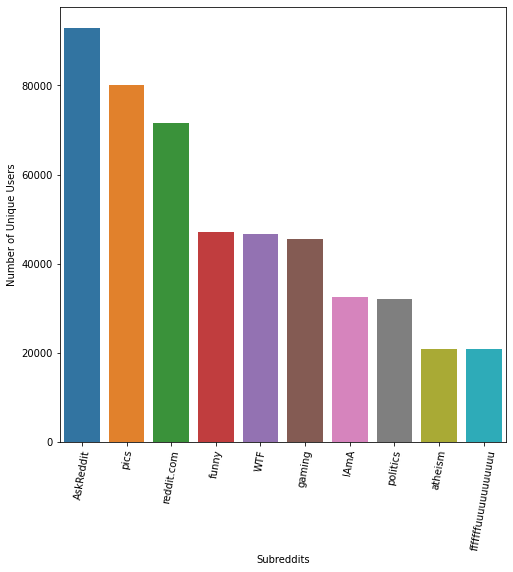
Looking at Figure 1, subreddits that seem more broad and common like 'gaming' and 'pics' are in the top 10 subreddits. Since they are broad, it is more likely that users will join these and be interested in these subreddits. In Figure 2, we look into the distribution of the number of comments made by users:
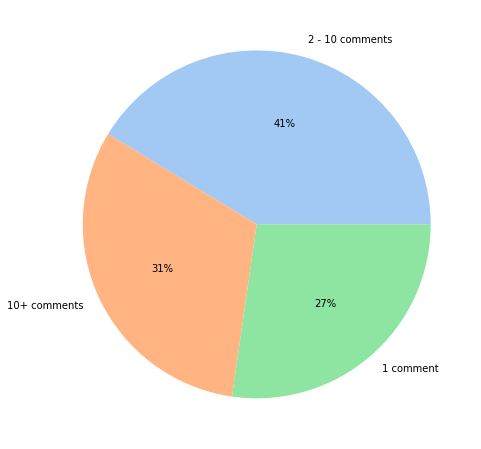
We see that 27% of users have made 1 comment, 41% of users have made between 2 and 10 comments, and 31% of users have made more than 10 comments.
Next, we look into the karma of users. On Reddit, karma is a score of a user/comment that is determined by the sum of all upvotes minus the sum of all downvotes. It is usually displayed publically next to the upvote and downvote buttons. First we look into the average karma for a comment by subreddit:
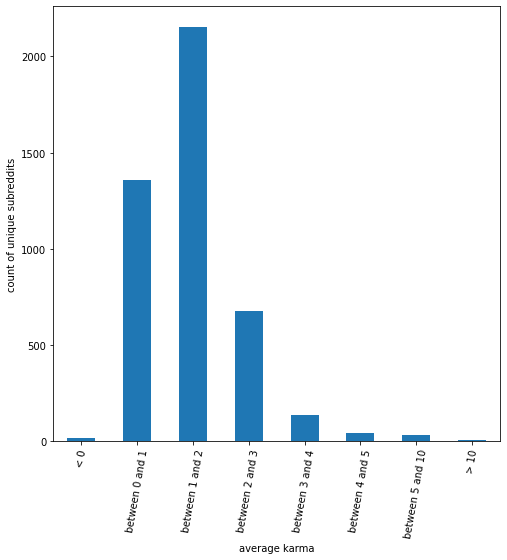
In Figure 3, we can see that most of these subreddits have an average karma for comments in the subreddit between 0 and 3. Next, we look into the average karma for a comment by user:
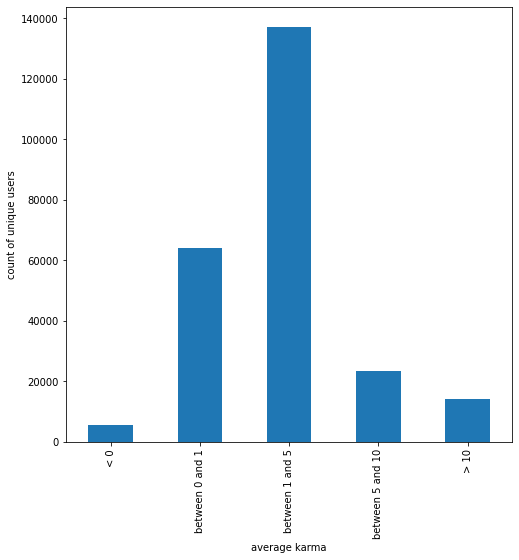
In Figure 4, we see that once again, a large majority of users have an average karma between 0 and 5 for their comments. Finally, we also analyze the distribution of users by karma:
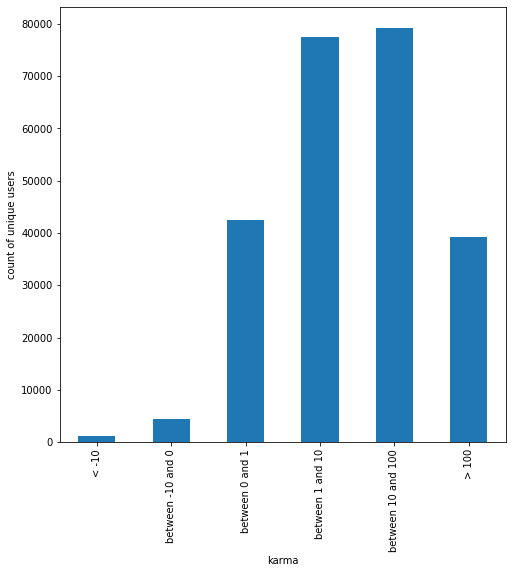
Figure 5 shows that a majority of users have between 1 and 100 karma associated with their accounts, while few users have negative karma. After this, we aim to look at the volume of comments by day. From our dataset, we find that the majority of comments are made in the month of December. Looking at Figure 6:
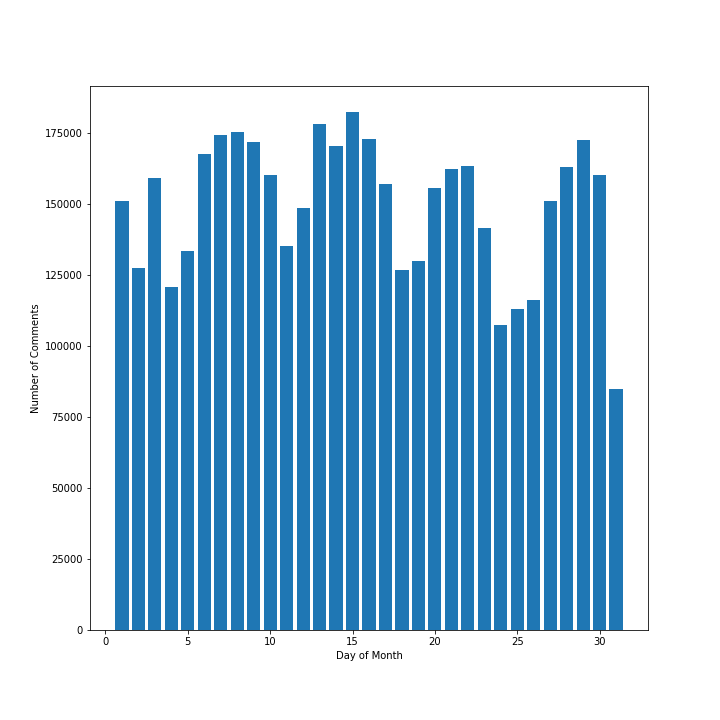
This doesn't give us much insight into large trends, but we do see that for the most part, there are several days where the volume of comments seems to be relatively similar to one another, meaning that there does not seem to be a special relationship between day of month and number of comments. Finally, we delve a bit deeper into comment chains, as that is where the biggest focus of our model is. We find that we have 942,558 comment chains in our data. Figure 7 shows the distribution of comment chain lengths.
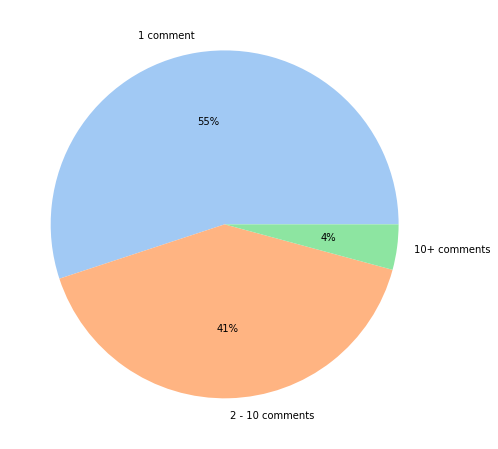
From Figure 7, we can see that the majority of comments do not actually belong to a comment chain. This means that the comment was posted and no-one replied. These data are likely not very useful in generating meaningful metrics for recommendation based on user comment interactions. However, 45% of the comment data are part of chains with 41% being 'small' chains of only 2 - 10 comments and the other 4% being long chains with over 10 comments. We can examine the distributions of both of these groups:
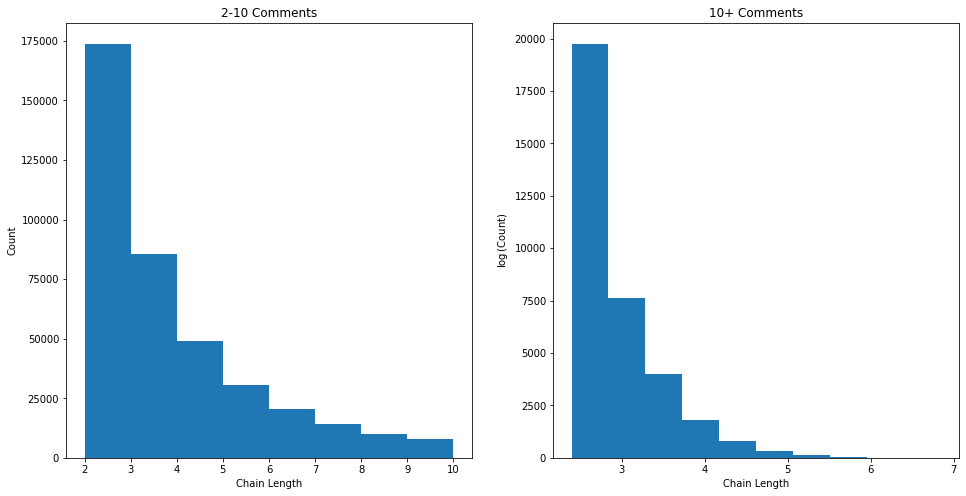
As we might expect, we generally have less chains of longer lengths. In short, there are mostly smaller chains in the data but the distribution is heavily right-skewed due to some very long chains.
Now we look at some data such as the number of users in each chain and the number of times users tend to interact in a chain. Figure 9 details the number of unique users per chain:
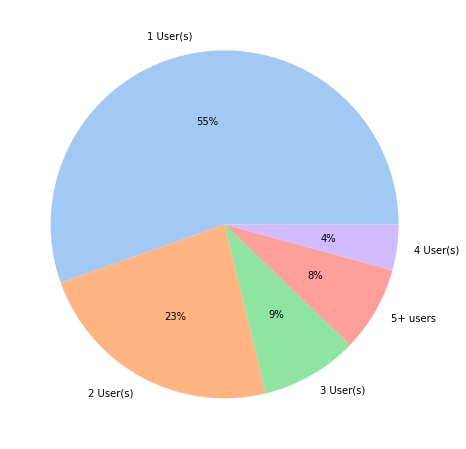
Next, we look at the ratio between the number of unique users in a chain and the total number of comments in that chain. This tells us how unique the set of users participating in a chain is. Smaller ratios means there is less diversity. We find that the chains are generally quite diverse as, on average, the number of unique users is very close to the total number of comments. However, because we are including chains of length one which the ration is guaranteed to be 1.0 for, this value is quite skewed. We remove those and try again:
| Minimum Number in Chain | count | mean | std | min |
| 1 | 428186.0 | 0.864 | 0.202 | 0.016 |
| 2 | 203798.0 | 0.829 | 0.202 | 0.016 |
| 3 | 117313.0 | 0.811 | 0.197 | 0.016 |
| 4 | 76377.0 | 0.800 | 0.191 | 0.016 |
| 5 | 54273.0 | 0.793 | 0.186 | 0.016 |
| 6 | 40719.0 | 0.788 | 0.181 | 0.074 |
| 7 | 32033.0 | 0.784 | 0.176 | 0.085 |
| 8 | 25871.0 | 0.781 | 0.173 | 0.085 |
| 9 | 21444.0 | 0.779 | 0.17 | 0.085 |
| 10 | 18123.0 | 0.777 | 0.166 | 0.085 |
This is more indicative of the data we wanted to see. Now, as we move towards larger and larger chains, the average ratio of unique users seems to plataeu at ~0.78 as indicated by Figure 10.
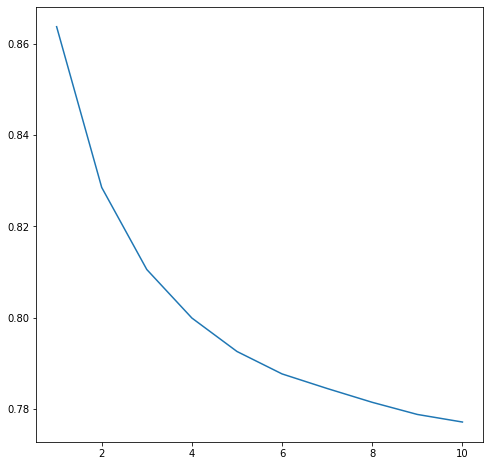
 4
4 
Baselines
 5
5 
Non-Graph Algorithms
The K-Nearest Neighbors algorithm we develop uses cosine similarity as the metric, and chooses 20 neighbors. Cosine similarity is a measure of similarity between two data points in a plane, and in a KNN is used to determine the distance between two points. This can be found mathematically as follows:
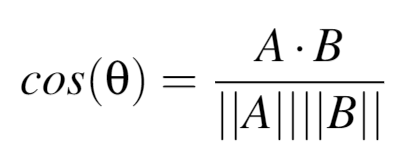
where A and B are two vectors of attributes.
The recommender system we develop uses Jaccard similarity to recommend subreddits to users. The Jaccard index is used to gauge the similarity and diversity of sets, and can be determined mathematically as follows:

A final baseline we tried was a simple popularity predictor model, which recommends users the most popular subreddits that they are not already subscribed to.
 5.1
5.1 
Centrality Algorithms
Closeness for Users: a measure of the average farness (inverse distance) to all other user nodes. Nodes with a high closeness score have the shortest distance to all other nodes. The closeness of a node x is determined by:
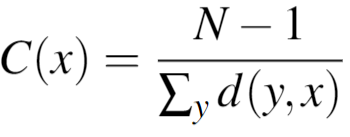
where N is the number of nodes in the graph, and d(y,x) is the length of the shortest path between user vertices x and y.
Betweenness for Users: This is a measure of the percentage of shortest paths to other users that must go through a specific user node. A user node with high betweenness is likely to be aware of what is going on in multiple circles. The equation for betweenness of a given node u is:

where σv,w is the total number of shortest paths from node v to node w, and σv,w(u) is the total number of shortest paths from node v to node w that pass through u.
Eigenvector for Users: eigenvector centrality is a measure of the influence of a node in a network. A high score means that a node is connected to many nodes who have high scores. For a given graph G := (V, E) with |V| vertices, where A = av,t is the adjacency matrix (i.e. av,t = 1 if the vertex v is linked to vertex t and 0 otherwise.). We can find the eigenvector centrality using:

Degree Centrality for Users: The number of edges a user node has. The higher the degree, the more central this user is.
Degree Centrality for Comments: The number of edges a comment node has. The higher the degree, the more central this comment is.
PageRank for Comments: PageRank counts the number and quality of links to a comment to determine how important that comment is, assuming that that comment is more likely to receive more connections to other comments.
PageRank for Users: PageRank counts the number and quality of links to a comment to determine how important that comment is, assuming that that comment is more likely to receive more connections to other comments.
 5.2
5.2 
Community Detection Algorithms
Louvain Algorithm: Louvain is a greedy community detection algorithm that focuses on optimizing modularity, which measures the relative density of edges inside communities with respect to edges outside communities. By optimizing modularity, Louvain results in the best possible grouping of nodes of a given network. In Louvain, small communities are first found by optimizing modularity locally on all nodes, then each small community is grouped into one node and the first step is repeated. The value modularity, Q is defined as:

where Aij represents the edge weight between nodes i and j, ki and kj are the sum of the weights of the edges attached to the nodes i and j, respectively. m is the sum of all the edge weights in the graph, ci and cj are the communities of the nodes, and δ is the Kronecker delta function ( δ(x,y) = 1 if x = y, 0 otherwise)
Label Propagation Algorithm: The Label Propagation Algorithm (LPA) is a fast algorithm for finding communities in a graph. The LPA works by propagating labels throughout the network and forming communities based on this process. The intuition behind this algorithm is that a single label can quickly become dominant in a densely connected group of nodes, but will have trouble crossing a sparsely connected region. Labels will get trapped inside a densely connected group of nodes, and those nodes that end up with the same label when the algorithms finish can be considered part of the same community. LPA works as follows:
- Every node is initialized with a unique community label, an identifier.
- These labels propagate through the network.
- At every iteration of propagation, each node updates its label to the one that the maximum number of its neighbors belongs to. Ties are broken arbitrarily but deterministically.
- LPA reaches convergence when each node has the majority label of its neighbors.
- LPA stops if either convergence, or the user-defined maximum number of iterations is achieved.
 5.3
5.3 
Final Model
To build the standard machine learning features, we first create a corpus of text for every user using all of the comments that user has posted. We then find the top 25 most influential words from that corpus by applying TFIDF and picking the top 25 highest scoring words. Then we use a pre-trained word2vec model which converts each of the 25 keywords into an embedding of length 50. This then gives each user an embedding of size 25 X 50, representing the keywords that the user is interested in. Combining the graph based features with the standard features results in each user having an embedding of size 1254. Using this size 1254 embedding, K-Nearest Neighbors is utilized to calculate the two most similar users to the input user. We then create a pool of possible subreddits to recommend. This pool consists of subreddits that the two neighboring users are active in that the input user isn't already interacting in. In order to determine what subreddits to recommend from this pool, we use a similar approach to our standard machine learning feature pipeline. For every subreddit node, we create a corpus which consists of text extracted from 25 randomly picked comments made in that subreddit. We follow the same process as above by picking 25 keywords for each subreddit using TFIDF scores. Same as above, we apply a pre-trained word2vec model to the keywords to create 25 X 50 size embeddings for each subreddit. We then train another K-Nearest Neighbors model on the pool of possible subreddits that we created earlier. From there, we iterate through the subreddits the user has already interacted in and use K-Nearest Neighbors to find the five most similar subreddits from the pool. These similar subreddits will be the recommendations that we output to the user. If the number of recommendations is greater than the total number of unique subreddits in the possible recommendation pool, the network statistics model uses the Popular Recommender to fill in those missing recommendations.
 6
6 
Results & Evaluation
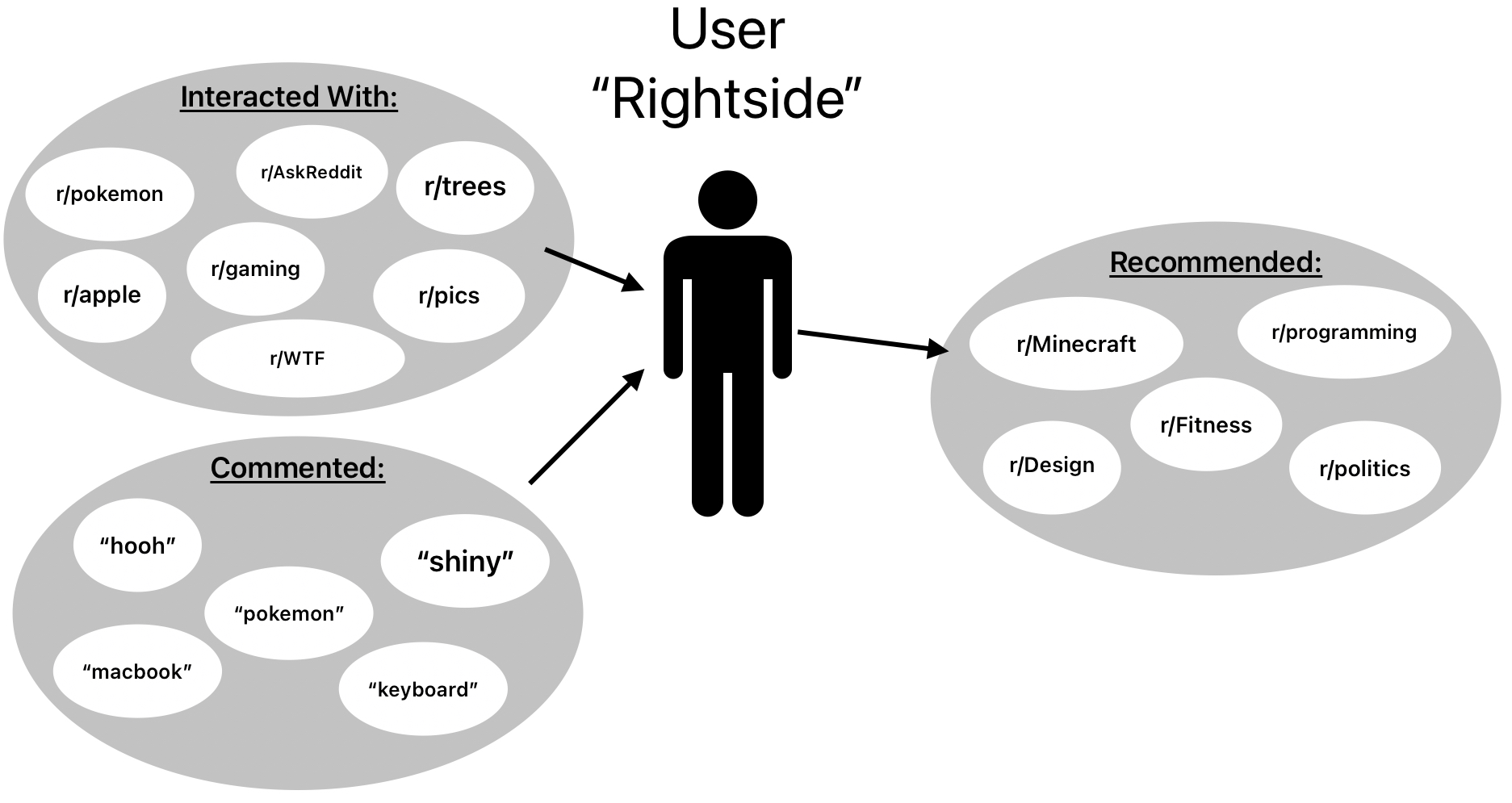
A user "Rightside" has interacted with certain subreddits as shown in the "Interacted With" bubble. When we train our model, we get certain keywords that are represented by the words in the "Commented" bubble. Finally, the "Recommended" bubble shows the recommendations that our model outputs. Subjectively, this result looks great!
However, we find that we run into a very common problem that many people face when trying to evaluate unsupervised recommender system models: how can we successfully evaluate our recommender system if there are no truth labels to compare to?
After researching several different methods, we decide to use Precision@k as our evaluation metric. Precision@k is the proportion of the recommended items in the top-k set of recommendations that are relevant.

We calculate these values by pulling data from 1 year in the future from the training data and examining all the Subreddits the training users interact in that they did not interact in before. Precision quantifies how well the recommendations we make match those true interactions. Our results are below:
| Algorithm | Graph-Based? | @1 | @3 | @5 | @10 | @25 |
| Popularity Recommender | No | 0.100 | 0.094 | 0.073 | 0.048 | 0.025 |
| Jaccard Similarity | No | 0.025 | 0.020 | 0.020 | 0.020 | 0.021 |
| Cosine Similarity KNN | No | 0.060 | 0.042 | 0.037 | 0.039 | 0.040 |
| Network Statistics Recommender | Yes | 0.000 | 0.021 | 0.034 | 0.071 | 0.075 |
Table 1 shows our results at different values of k; specifically, when @k is 1, 3, 5, 10, and 25. When @k is 10 and 25, our final model outperforms standard recommendation techniques. However, our model fails to surpass standard models when @k is 1, 3, or 5. We believe that this under-performance may be due to the bias of users only interacting in the most popular subreddits at the time and not exploring new and upcoming subreddits based on their personal interests. As we mentioned earlier, our model was trained on data from 2010, when Reddit was relatively new and most user interactions were happening in the most popular subreddits. This is why we see such a successful precision@k for our popularity recommender that just recommends the most popular subreddits in the data set that a user is not already part of.
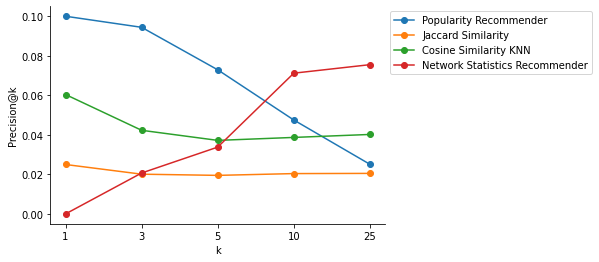
 7
7 
Conclusion
 8
8 
Future Work/Next Steps
 8.1
8.1 